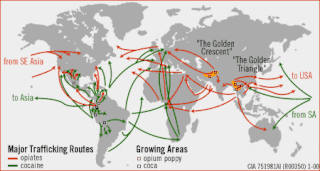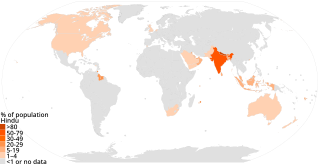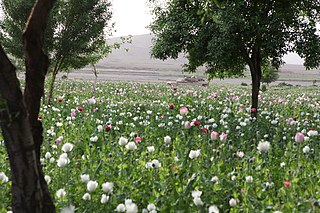
Bangladesh is the eighth-most populated country in the world with almost 2.2% of the world's population. As per the 2022 Census of Bangladesh, the country's population is 165,158,616.

The illegal drug trade or drug trafficking is a global black market dedicated to the cultivation, manufacture, distribution and sale of prohibited drugs. Most jurisdictions prohibit trade, except under license, of many types of drugs through the use of drug prohibition laws. The think tank Global Financial Integrity's Transnational Crime and the Developing World report estimates the size of the global illicit drug market between US$426 and US$652 billion in 2014 alone. With a world GDP of US$78 trillion in the same year, the illegal drug trade may be estimated as nearly 1% of total global trade. Consumption of illegal drugs is widespread globally and it remains very difficult for local authorities to thwart its popularity.

Hinduism has approximately 1.2 billion adherents worldwide. Hinduism is the third largest religion in the world behind Christianity (31.5%) and Islam (23.3%).

The United States Central Intelligence Agency (CIA) has been accused of involvement in drug trafficking. Books and investigations on the subject that have received general notice include works by the historian Alfred McCoy, professor and diplomat Peter Dale Scott, journalists Gary Webb and Alexander Cockburn, and writer Larry Collins. These claims have led to investigations by the United States government, including hearings and reports by the United States House of Representatives, Senate, Department of Justice, and the CIA's Office of the Inspector General.

The Golden Triangle is the area where the borders of Thailand, Laos, and Myanmar meet at the confluence of the Ruak and Mekong rivers. The name "Golden Triangle"—coined by the CIA—is commonly used more broadly to refer to an area of approximately 950,000 square kilometres (367,000 sq mi) that overlaps the mountains of the three adjacent countries.

Afghanistan has long had a history of opium poppy cultivation and harvest. As of 2021, Afghanistan's harvest produces more than 90% of illicit heroin globally, and more than 95% of the European supply. More land is used for opium in Afghanistan than is used for coca cultivation in Latin America. The country has been the world's leading illicit drug producer since 2001. In 2007, 93% of the non-pharmaceutical-grade opiates on the world market originated in Afghanistan. By 2019 Afghanistan still produced about 84% of the world market. This amounts to an export value of about US$4 billion, with a quarter being earned by opium farmers and the rest going to district officials, insurgents, warlords, and drug traffickers. In the seven years (1994–2000) prior to a Taliban opium ban, the Afghan farmers' share of gross income from opium was divided among 200,000 families. As of 2017, opium production provides about 400,000 jobs in Afghanistan, more than the Afghan National Security Forces. In addition to opium, Afghanistan is also the world's leading producer of hashish.
Human immunodeficiency virus and acquired immune deficiency syndrome in Burma is recognised as a disease of concern by the Ministry of Health and is a major social and health issue in the country. In 2005, the estimated adult HIV prevalence rate in Burma was 1.3%, according to UNAIDS, and early indicators show that the epidemic may be waning in the country, although the epidemic continues to expand in parts of the country. Four different strains of HIV are believed to have originated from Burma, along heroin trafficking routes in northern, eastern and western Burma.
The French Connection was a scheme through which heroin was smuggled from Indochina through Turkey to France and then to the United States and Canada, sometimes through Cuba. The operation started in the 1930s, reached its peak in the 1960s, and was dismantled in the 1970s. It was responsible for providing the vast majority of the heroin used in the United States at the time. The operation was headed by Corsican criminals Paul Carbone and Antoine Guérini, and also involved Auguste Ricord, Paul Mondoloni and Salvatore Greco.
Crime in India has been recorded since the British Raj, with comprehensive statistics now compiled annually by the National Crime Records Bureau (NCRB), under the Ministry of Home Affairs (India) (MHA).
The illegal drug trade in China is influenced by factors such as history, location, size, population, and current economic conditions. China has one-fifth of the world's population and a large and expanding economy. China's large land mass, close proximity to the Golden Triangle, Golden Crescent, and numerous coastal cities with large and modern port facilities make it an attractive transit center for drug traffickers. Opium has played an important role in the country's history since before the First and Second Opium Wars in the mid-19th century.
This article deals with activities of the U.S. Central Intelligence Agency related to transnational crime, including the illicit drug trade.

Crime in Afghanistan is present in various forms, and includes the following: corruption, contract killings or assassinations, bombings, kidnapping, drug trafficking, money laundering, black marketeering, and ordinary crimes such as theft and assault.
Crime is present in various forms in China. The Chinese government does not release unified exact statistics on crime rates and the rate of criminal offending due to such information being considered sensitive. Scarce official statistics released are the subject of much academic debate due to allegations of statistical fabrication, under-reporting and corruption.

The crime rate in Oman is low compared to other industrialized countries. Incidents of serious crime are rare in the country. Incidents of petty crime are occasionally reported, including burglary and theft of property of foreign tourists. The Foreign and Commonwealth Office (FCO) describes the law and order situation in Oman as "generally good". Incidence of street crime is low. Violent crime occurs, but is extremely low compared to the rest of the Middle East.

Crime in the Maldives ranks from low to moderate, but crime rates in the country have increased significantly in recent years. Incidents of theft on beaches or in hotels do occur. Juvenile delinquency is a growing problem in the Maldives. According to the data available from the Ministry of Defence and National Security, there has been an increase in petty crime in the country. In 1992, 169 cases of petty crime were reported, while the number was 462 in 1996. The number of sentenced persons under the age of 19 also increased from 391 in 1988 to 512 in 1998. Fraud examiner Peter Lilley in his book Dirty Dealing writes that money laundering is not a significant problem in the Maldives.

The illegal drug trade in Latin America concerns primarily the production and sale of cocaine and cannabis, including the export of these banned substances to the United States and Europe. The Coca cultivation is concentrated in the Andes of South America, particularly in Colombia, Peru and Bolivia; this is the world's only source region for coca.

Adherents of Islam constitute the world's second largest religious group. According to an estimation in 2022, Islam has 1.97 billion adherents, making up about 25% of the world population. A projection by the PEW suggests that Muslims numbered approximately 1.90 billion followers in 2020. Studies in the 21st century suggest that, in terms of percentage and worldwide spread, Islam is the fastest-growing major religion in the world, mostly because Muslims have more children than other major religious groups. Most Muslims are either of two denominations: Sunni or Shia. Islam is the majority religion in several subregions: Central Asia, West Asia, North Africa, West Africa, the Sahel, and the Middle East. The diverse Asia-Pacific region contains the highest number of Muslims in the world, easily surpassing the combined Middle East and North Africa.
Drug smuggling is an issue that is gaining international attention, particularly in the Indian Ocean region. The Indian Ocean borders 24 states, and accounts for a third of the world’s ocean area. Previously, other challenges, such as Somali piracy, have been at the forefront of international action. However, the utilisation of the Southern route by drug traffickers, and the consequent issues this has caused, has led to increased focus on how to tackle this issue.
Seychelles is a small island nation with a vast maritime territory, consisting of 115 islands and a 137 million square kilometer Exclusive Economic Zone. The prevalence of drugs in the country is high and the country is experiencing a heroin epidemic, with an equivalent to 10% of the working force using heroin in 2019. Due to its location along a major trafficking route, drugs can easily be trafficked by sea to Seychelles.











